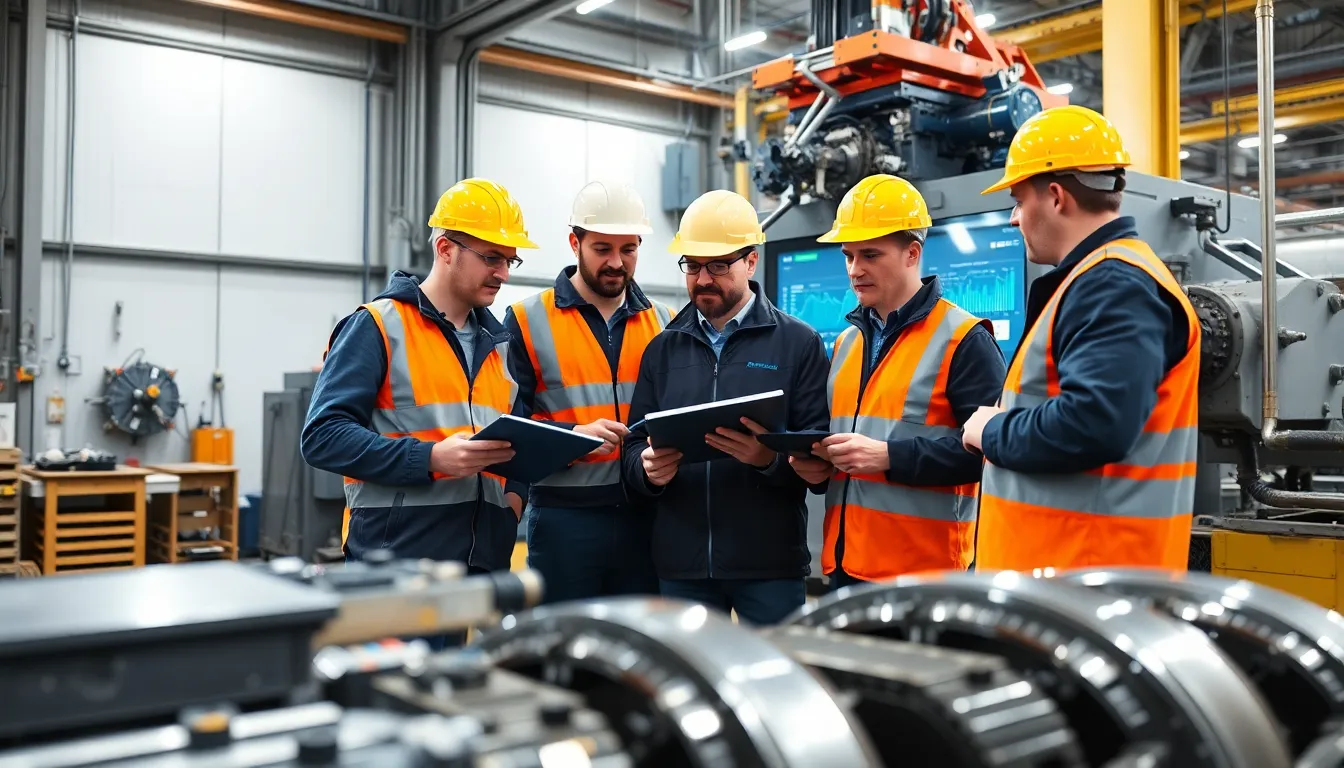In a world where machines often break down at the most inconvenient times, predictive maintenance powered by artificial intelligence is like having a crystal ball for equipment health. Imagine knowing when your machines are about to throw a tantrum—saving time, money, and a whole lot of headaches. With AI’s ability to analyze data faster than a caffeinated squirrel, businesses can now anticipate issues before they spiral into costly disasters.
Gone are the days of waiting for a machine to break down before fixing it. Predictive maintenance is here to keep operations running smoothly, like a well-oiled machine—pun intended. By leveraging AI, companies can not only enhance efficiency but also extend the lifespan of their assets. So buckle up and get ready to discover how this innovative approach is changing the game in maintenance and making engineers’ lives a whole lot easier.
Table of Contents
ToggleWhat Is Predictive Maintenance?
Predictive maintenance utilizes data analytics and artificial intelligence to forecast equipment failures before they occur. It focuses on proactive care rather than reactive repairs, ultimately improving operational efficiency.
Definition of Predictive Maintenance
Predictive maintenance refers to a maintenance strategy that predicts failures through data analysis. This method leverages AI models to analyze historical and real-time data, revealing potential equipment issues. Predictive models utilize various data points, such as temperature, vibration, and historical failure rates. With accurate predictions, organizations can schedule maintenance activities at optimal times. This approach minimizes unplanned downtime and reduces maintenance costs significantly.
Importance in Modern Industry
Predictive maintenance plays a crucial role in modern industry by enhancing operational reliability and efficiency. Many organizations are adopting this method to transform their maintenance processes. Not only does it save considerable amounts of money, but it also minimizes disruptions in production. Additionally, it leads to increased asset lifespan and improved safety standards. Companies that apply predictive maintenance often experience a competitive advantage, as they can respond swiftly to potential issues before they escalate. Ultimately, predictive maintenance supports a shift towards a more data-driven and efficient operational model.
Role of Artificial Intelligence in Predictive Maintenance

Artificial intelligence plays a critical role in predictive maintenance by enhancing the ability to foresee equipment malfunctions. It drives operational efficiency by leveraging advanced analytics techniques.
Machine Learning Algorithms
Machine learning algorithms enable systems to recognize patterns in data. These algorithms, including decision trees and neural networks, analyze historical data to identify trends leading to equipment failures. They continuously learn from incoming data, allowing adjustments to predictive models. Implementing these algorithms leads to better accuracy in predictions. Various industries, from manufacturing to healthcare, benefit from reduced downtimes and lower maintenance costs. Enhanced predictive capabilities support timely interventions, maintaining productivity levels.
Data Analysis Techniques
Data analysis techniques serve as the backbone of predictive maintenance initiatives. Techniques such as time-series analysis and clustering provide insights into equipment behavior. Time-series analysis examines data collected over intervals, revealing valuable trends. Clustering categorizes similar data points, identifying anomalies that signal potential issues. Real-time data analysis surfaces invaluable information on operational health. Organizations harness these techniques to optimize maintenance schedules. Improved decision-making results from the actionable insights they generate, further boosting overall efficiency.
Benefits of Predictive Maintenance Artificial Intelligence
Predictive maintenance powered by artificial intelligence offers numerous advantages, greatly enhancing operational efficiency. Organizations experience significant cost savings and improved equipment reliability.
Cost Reduction
Cost reduction becomes apparent through fewer unexpected breakdowns, allowing for more efficient budgeting. Companies minimize expenses associated with emergency repairs and replacement parts. AI-driven insights facilitate optimized maintenance schedules, ensuring resources are allocated effectively. With predictive maintenance, organizations reduce labor costs tied to excessive manual inspections. Ultimately, these financial benefits contribute to stronger profit margins.
Increased Equipment Lifespan
Increased equipment lifespan results from early detection of potential failures. By addressing issues before they escalate, companies protect asset integrity and functionality. Regularly scheduled maintenance, informed by real-time data analysis, prevents unnecessary strain on machinery. Enhanced reliability leads to longer operating periods, reducing the need for replacements. Predictive maintenance strategies empower organizations to maximize the value of their investments while minimizing downtime.
Challenges and Limitations
Predictive maintenance using artificial intelligence faces several challenges and limitations affecting its effectiveness in operations. Understanding these hurdles helps organizations make informed decisions.
Data Quality Issues
Data quality represents a critical challenge for predictive maintenance initiatives. Inaccurate or incomplete data can lead to flawed predictions. Organizations must ensure that data collected from sensors is reliable and consistent to maintain prediction accuracy. A lack of historical data for specific equipment also complicates analysis, making pattern recognition difficult. Additionally, noise in the data may mask significant trends, further hindering effective decision-making. Addressing these data quality concerns allows for improved model training and ultimately enhances the performance of AI-driven predictive maintenance systems.
Integration with Existing Systems
Integrating AI-powered predictive maintenance with existing systems poses another significant challenge. Legacy systems often lack compatibility with modern technology, creating obstacles in data flow and analysis. Organizations may face difficulties in adapting their current processes to accommodate new AI tools. Furthermore, teams must invest in training to ensure staff understands how to utilize these advanced systems effectively. A seamless integration demands thorough planning and a clear understanding of both technological capabilities and existing workflows. Achieving this balance leads to smoother transitions and more effective predictive maintenance strategies.
Future Trends in Predictive Maintenance Artificial Intelligence
Predictive maintenance continues evolving, fueled by advancements in technology and the growing impact of the Internet of Things (IoT). These developments enhance accuracy and real-time capabilities of maintenance strategies.
Advancements in Technology
New algorithms in artificial intelligence improve the precision of predictive maintenance. Algorithms analyze vast datasets faster and more accurately. Enhanced data processing capabilities allow businesses to extract more meaningful insights from historical and real-time data. Furthermore, advancements in cloud computing facilitate better data storage and accessibility, enabling organizations to access critical information anytime. Incorporating edge computing also allows data processing closer to the source, reducing latency and improving response times for maintenance actions. Therefore, organizations can achieve higher operational efficiency and reduced downtimes.
Growth of IoT and Its Impact
The growth of the Internet of Things revolutionizes predictive maintenance practices. IoT devices collect a wealth of performance data from machinery, creating a continuous stream of information. These connected devices facilitate real-time monitoring and data analysis, enabling quicker detection of anomalies. Organizations employing IoT technology can proactively respond to equipment issues before they escalate. Additionally, by integrating IoT with AI, predictive maintenance becomes smarter, as machine learning enhances the understanding of equipment behavior. This synergy drives lower maintenance costs and maximizes equipment uptime in various industries.
Predictive maintenance powered by artificial intelligence is reshaping how industries manage their equipment. By leveraging data analytics and machine learning, organizations can anticipate failures and optimize maintenance schedules. This proactive approach not only enhances operational efficiency but also extends the lifespan of assets.
As technology continues to evolve, the integration of IoT and advanced AI algorithms will further refine predictive maintenance strategies. Companies that embrace these innovations will likely see significant cost savings and improved reliability. The future of maintenance lies in data-driven decision-making, enabling businesses to stay ahead in a competitive landscape.

